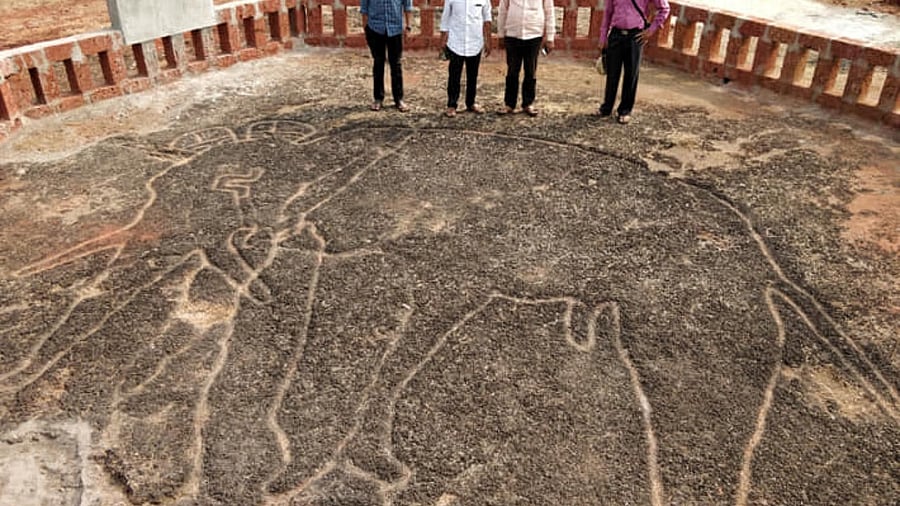
The geoglyphs/petroglyphs of the Konkan, Goa, and Southern Karnataka are unique and is the most remarkable open-air ensemble of prehistoric human expression of rock art.
Credit: Special Arrangement
Mumbai: The Maharashtra government has intensified efforts to include the Geoglyphs of Konkan in UNESCO World Heritage Site. The state government is also in touch with the Centre on this issue and is engaged in extensive documents.
As of now nine sites are in the UNESCO Tentative List.
Geoglyphs are rock art produced on the surface earth either by positioning rocks, rock fragments or by reduction technique - carving out or removing part of a rock surface to form a design.
These Geoglyphs of Konkan are more than 10,000 to 12,000 years old - and are very significant to learn more about our past in this sub-continent.
At a meeting in Mumbai, state Cultural Affairs Minister Ashish Shelar asked for comprehensive documentation and meticulous data collection of these sites.
“This critical step will pave the way for their inclusion in UNESCO’s prestigious World Heritage Sites list, showcasing Maharashtra’s cultural legacy on the world stage,” Shelar said at a meeting chaired by him at the P L Deshpande Maharashtra Kala Academy in Prabhadevi on Monday.
Additional Chief Secretary to the Chief Minister and Cultural Affairs Department Vikas Kharge, Director of Archaeology and Museums Dr Tejas Garge, representatives from the Nisarg Yatri Organisation of Ratnagiri and senior officials from the Department of Cultural Affairs were present for the meeting.
“Following a visit by a Spanish delegation to some of these sites, a formal proposal has been initiated to include these sites in the UNESCO World Heritage list,” Shelar said and stressed the need for nationwide awareness, public engagement and global outreach to elevate the profile of these cultural treasures.
The Cultural Department has been instructed to produce an international-standard documentary showcasing these sites and creation of an extensive archive of high-quality photographs and videos, stressing the importance of leveraging advanced technology to present this visual content effectively.
Kharge underlined the necessity that a time-bound program must be launched to survey and map all such sites across the state. “Schemes should be developed to ensure conservation of protected rock carving sites,” he said.
In fact, rock art in India is one of oldest material evidence of the country's early human creativity.
For some time archaeologists, geologists and heritage lovers have been calling for the inclusion in the World Heritage Site list.
In the Tentative List, there are nine sites - eight in Maharashtra and one in Goa.
The eight Maharashtra sites are - Jambhrun, Ukshi, Kasheli, Rundhetali, Devihasol, Barsu, DevacheGothane, Kudop while the Goa site is Pansaymol.
Scholars have pointed out the similarities of this composition with a motif depicted on at least two seals reported from the excavated sites of the Harappan Civilization-Harappa and Mohenjo-Daro.
Known as Aparanta, the Konkan region was a culturally vibrant land since the early historical period, according to the Tentative Lists of States Parties submitted to UNESCO. The region witnessed flourishing trading activities and complex maritime and inland trade linkages. It was connected to the Western Ghats through major communication corridors (called ghats) and the landscape were dotted with numerous forts, to protect the series of ports that were the critical linkage between the subcontinental and foreign shores. This made Konkon region the most sought after political-geography, contested by the Mauryas, Satvahanas, Shilaharas, Rashtrakutas, Kalchuris, Chalukyas, Vijaynagaras, Deccan Sultanates, Mughals, Marathas, also by the colonial powers such as Portuguese, Dutch and later the British alike.
While remains of continued habitation since early historic life is evident in the form of several affluent port towns, trading towns and routes, rock-cut caves, forts, colonies of foreign powers in form of factories, castles and towns, there is little evidence besides these Geoglyphs, to demonstrate prehistoric life of this region, which enabled the indigenous population to leverage from their landscape. These clusters of Geoglyphs covering about 900 km from north to south, along the coastline of the Arabian sea, show the expanse of initiation of culture in Konkan and provide visual representation of prehistoric life here.